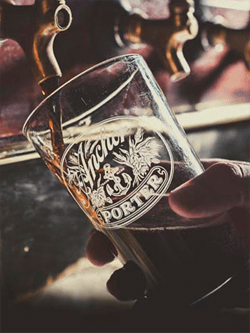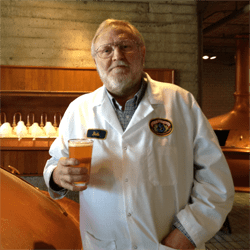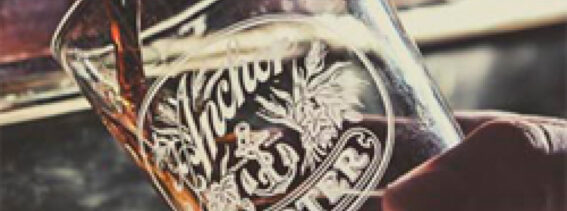Question (via email): How can I order my favorite beer at my local bar and test to see if they’re serving it correctly? Am I getting the best possible product presentation?
Bob: When ordering in a bar, there are several things to look for when being served up your favorite beer – or any beer for that matter. Appearance can tell a lot right away. Pouring technique, temperature, and taste all figure into the equation.
WHAT TO LOOK FOR
After ordering the beer, try to watch how the bartender pours it. The glass should be held up to the faucet at a 45 degree angle, which allows the beer to flow down the side. The glass should be gradually turned upright as it fills. The faucet should never come into contact with the head on the beer. The resulting pour should have a tight ½-inch head. Any more than that and the pour is sloppy and you are not getting your money’s worth. A foamy pour will also release too much CO2 from the beer and result in a loose head with large bubbles that quickly goes flat.

Before taking a sip, look at the glass. There may be a stream of tiny bubbles rising from the bottom. This is normal and a good thing. If there are large bubbles sticking to the sides of the glass from top to bottom, that is not a good thing. This indicates that the glass has not been properly washed, or in other words, is not “beer clean.”
The head of foam should not dissipate quickly, but should remain on the beer even after a few drinks. After each drink, as the level of the beer in the glass drops, the lowering head should leave a lacey ring on the inside of the glass. This “lace” is an indication of a clean glass as well as a proper pour.
WHAT TO TASTE FOR
Is the beer cold? It should be. Not freezing, but in the range of 40 degrees, plus or minus 2. I realize that there is debate concerning the proper temperature at which any particular beer should be enjoyed for the best experience, i.e. stout being served warmer. But beer pours best, cleanest, and less wasteful at about 40 degrees.
Drinking temperature and serving temperature are two different things. A cold serve indicates that the beer has been properly refrigerated and handled by the bar which is another good thing. As far as drinking temperature is concerned, if you feel the beer is served too cold, be patient and let it warm up in the glass to where you prefer it.
What does the beer taste like? Is it what you expected and everything else looks good? If so, great! Cheers! But if everything else here looks good but you think the taste is wrong, there are a few things to consider.
Is it a beer that you are familiar with or is it a new experience? Unfamiliar beers, even though labeled as a style that you know, may come across as strange or somehow “off.” If you suspect this, ask the bartender or another customer for their opinion. If it is an old favorite and you think that there is definitely something wrong with the beer, send it back with your concerns. The bar wants to keep its customers happy and appreciates feedback. A discussion of off flavors and their causes is a lengthy and involved affair that requires a seminar setting to address properly, but there are a few basic causes I can cover here.
Beer from the brewery is spoiled or just plain poorly-crafted. It happens far more often than you might think. Fortunately most brewers get the message quickly and correct the issue if they want to stay in business.
Beer has been in inventory and/or transport for too long and has gotten really old. This happens, too, even though we try as hard as we can at the brewery level to keep our beer fresh, we cannot control every aspect of distribution at every level.
Dirty beer lines. This one is probably the most common and, for me, the most frustrating. Beer lines need to be cleaned twice a month. Line cleaning is the responsibility of the beer wholesaler except in a few states where it is on the retailer. It is never the responsibility of the brewery. With the popularity of craft beer today, many establishments have 20, 30, or more taps which have refrigerated beer lines extending to walk in refrigerators, often located 50 feet or more from the bar. These long lines can contain from 1 to 3 or more pints of beer between the keg and the faucet. Lack of regular cleaning can cause the beer in the line to pick up off flavors if it sits there long enough.
In the case of a 30-tap bar, any given pint of specialty or less popular beer might sit in the line for many hours or even a day or two. This is most noticeable in the first beer of the day. If several beers are poured in quick succession, the problem goes away as the beer in the lines is flushed through, only to reappear the next day after beer has been sitting in the line overnight.
I’ve encountered this many, many times. It can be difficult to convince a bar that their beer is off if you get the first pint with all of the off taste and they pour the second one that is clean. It’s like when your car stops making that funny noise as soon as you take it to the mechanic. Hint here: Never be the first person of the day to order a barley wine or a double imperial dark rye IPA from that 30-tap bar.
Fortunately for us all, bad-tasting beer is becoming increasingly rare as the craft retailers and consumers become better educated and more discriminating. Proper serving is the norm, but if you think there is something amiss with your beer, don’t be afraid to say something. After all, you are the customer that we all depend on and you are always right.
Ask Bob A Question

Do you have a question you’d like to see answered in “Ask Bob Brewer?” Submit your question in the comments below or post it on our Facebook page.

